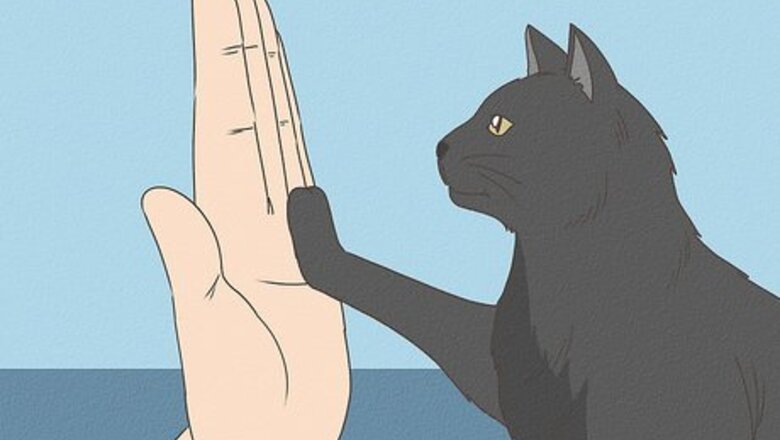
views
- Train your cat in short bursts, using treats and a clicker as a reward. Teach your cat one trick at a time, and only switch to a new one after they've mastered the previous trick
- Teach your cat to sit by holding a treat over its head. If it tries to reach the treat and sits down in the process, give it the treat as a reward.
- Teach your cat to give high-fives by showing it a treat and then closing it in your hand. If it uses its paw to try to grab the treat, give it the treat as a reward.
- Practice these tricks several times a day until your cat starts doing them even when you're not holding a treat.
Can cats learn tricks?

Yes, cats can definitely learn tricks. Training sessions with your cat are a great way to keep your feline friend alert and engaged. Plus, it can be a great bonding experience! The key is keeping training sessions brief, which holds your cat's attention so it will want to keep trying.
Cat Training Best Practices

Get a supply of treats. Cats need to be constantly rewarded with tasty treats to learn tricks. Keep plenty of your cat's favorite bite-sized treats on hand when trying to train it. Give your cat frequent treats when training it in short sessions. You can also vary treats frequently to keep your cat interested. Some good choices are: Diced chicken Bits of tuna Commercial cat treats Small pieces of dry food
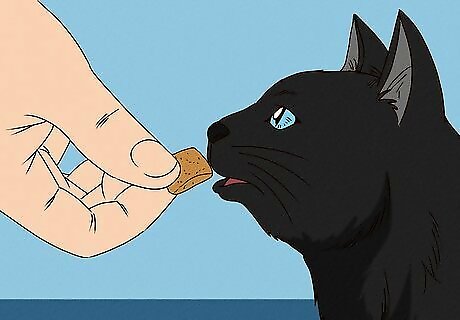
Get your cat's attention. Your cat won't want to learn tricks if it's not in the mood. Starting by giving your cat a treat might get its attention, which you can do with small, moving objects (like a toy mouse or feather tied to a string).If your cat doesn't act interested in learning a particular trick, don't force it to play—just be patient and try again later.
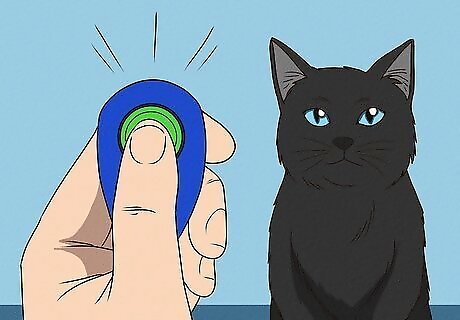
Use a clicker. A pet clicker is a small device that makes a clicking sound. Each time your cat does something you want it to (like a trick), make the clicking sound and give it a treat. The sound and positive reinforcement (reward) of the treat condition your cat to repeat the behavior. Pet clickers can be found at pet supply stores. If you can't find one, you can try a pen that makes a clicking noise.
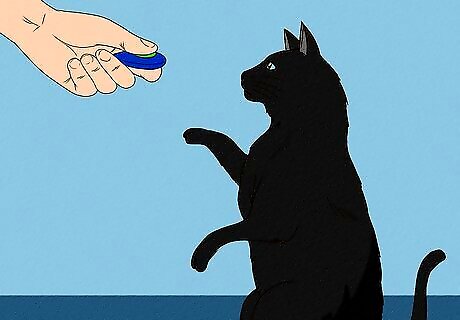
Keep training sessions short and frequent. Cats learn through repetition, so frequent training sessions will help them master a trick. Try repeating tricks several times each day.
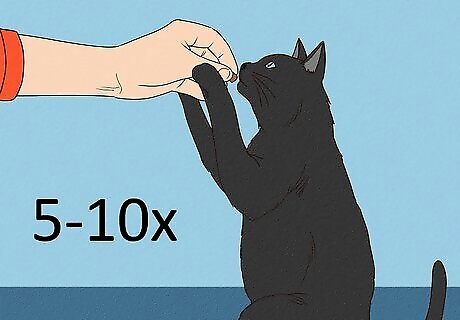
Repeat tricks when training your cat. When your cat completes a trick, give it a treat. Then try to get your cat to repeat the trick 5-10 times in a row (giving it a treat each time), as long as they are interested. This repetition will encourage behavior.

Don't use cue words until after the cat has learned a trick. For instance, if you want your cat to sit, don't use the word “sit” until it is used to doing the trick. This will help the cat associate the word specifically with the trick.
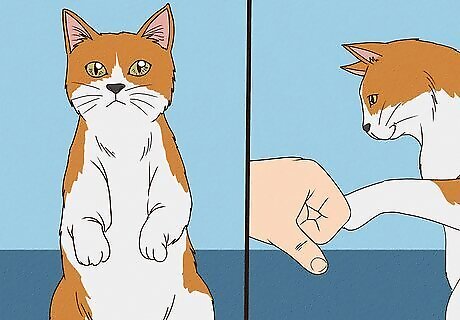
Teach one trick at a time. Positive reinforcement like praise and treats as your cat learns a trick will help it to master the behavior. Trying to teach it more than one trick at a time can confuse it, however, because it may not understand what behavior is being rewarded. Wait until your cat has mastered one trick before moving on to the next.

Do not punish your cat for not learning a trick. When given rewards and positive reinforcement, as opposed to punishments, cats learn much better. Scolding or punishing your cat when it doesn't complete a trick will only make it stressed or disinterested. If your cat doesn't act interested in learning a trick or doesn't perform successfully, just try again later. Take cat breaks so they look forward to learning.
Easy Tricks

Teach your cat to sit. When your cat is on all four feet, hold a treat in front of its face to get its attention and slowly move it to between its ears. Many cats will follow the treat in the air and lower their rear end to get it. When your cat sits, positively reinforce its behavior by praising it and giving it the treat. If your cat's rear end doesn't quite touch the ground the first time, give it the treat anyway. Keep repeating this training and your cat can get better each time.

Teach your cat to “hi-five.” First, encourage your cat to move its paw by giving it a treat each time it lifts the paw off of the ground. Then, put a treat in your hand (wrapped in your fist, for instance), and wait for your cat to use its paw to try and grab it out of your hand. Give the cat a treat as a reward when it does. Repeat this many times, gradually lifting your hand higher each time until the behavior resembles giving a hi-five.
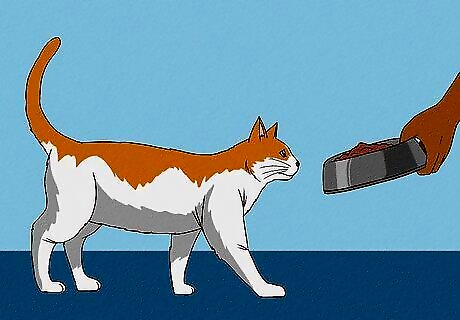
Train your cat to come when called. Try this training your cat for this trick at is mealtimes because it will already be hungry. Call your cat's name and tap on its food bowl to get its attention. When your cat comes, praise them and give them a treat. When your cat gets used to coming when called, you can also use the command “come” for this trick. You can vary this trick by trying to train your cat to come from distances increasingly farther away, from outside to inside, etc.
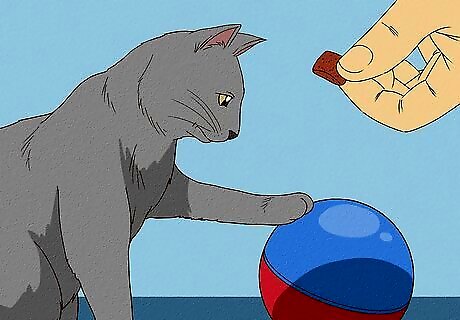
Train your cat to touch an object. You can have your cat learn to touch an object like a toy or a sturdy surface that will not fall over. This trick is learned best after your cat has learned to sit. Once your cat is sitting next to the object, hold a treat near it to attract the cat. When the cat touches the object, give it a treat. Once your cat becomes interested in this trick, you can also train it to touch the object with a specific type of its body. For instance, if you want to train it to touch an object with its paw, wait to give your cat a treat until it does.
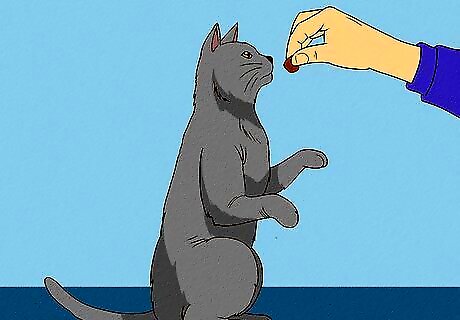
Train your cat to sit up on two legs. Hold a treat above your cat, but not so close that it can touch it. When your cat sits up on its hind legs, and reaches for the treat with its front paws, use a command like “sit” and give it the treat.
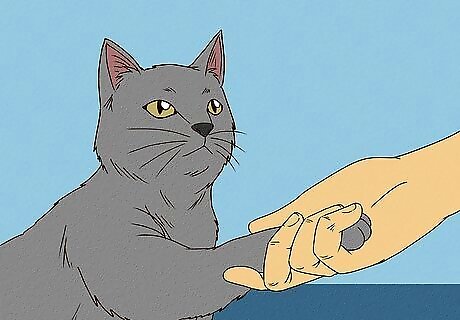
Teach your cat to shake hands. Sit in front of your cat and gently touch its paw. When it lifts the paw off the ground, grasp it in yours as though you were shaking hands. Give your cat a treat immediately afterward.

Train your cat to meow on command. Cats are capable of producing a wide range of vocal sounds (meows, chirps, trills, yowls, etc.), and they reserve most of them for communicating with humans. You can try training your cat to produce a meow or other sound on command. Just give your cat a treat when it makes the desired sound. After the cat begins to associate the treat with a reward, introduce a word like "meow" or "chirp" to create the command.



















Comments
0 comment